Diverse tastes create food openings for farmers
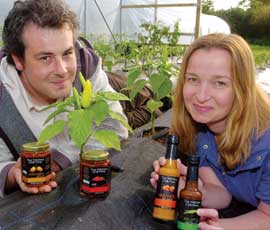
Whether it’s a trip to the local Indian or cooking a Mexican at home, the culinary tastes of the British have never been more varied. Aly Balsom talks to three farmers tapping into the global food market
The Chillie farmer
As my eyes water and my throat starts to warm, I realise you should never trust a chilli farmer when he says “it’s not that hot”.
And I was only trying an innocent-looking, pepper-like specimen. I dread to think the effects a spoonful of the sauce in a green bottle labelled with a skull could have.
“You have to be a bit sadistic to be a chilli farmer,” says Jamie Sythes (pictured above with partner Julie Cure) of The Wiltshire Chilli Farm.
You might think the hot stuff must only be popular with over-confident macho men, but Jamie reckons tastes are changing. A broad range of people from their teens to 70-plus are wanting hotter and hotter products.
“Tastes have evolved. Hot food gets addictive and, the more you eat, the hotter you want. We have a big following of ‘insane people’ and as a chilli farmer I need to cater for all tastes,” he says.
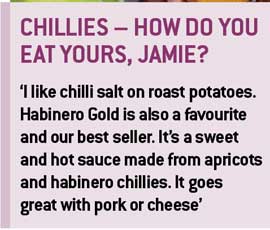
The Wiltshire Chilli Farm is the second biggest producer in the UK with 4,000 chilli plants grown across two sites in the county. Milder products are sold in 70 farm shops, with 100-200 farmers markets attended every year. The dedicated chilli shop in Bath, The Chilli Hut, caters for a specific customer who requires something with an extra kick.
The current business is a far cry from the initial 50 plants put in as a trial in 2009 with a £200 investment. And all this has been achieved without borrowings. However, the success of the business is far from just luck. As an ex award-winning business analyst, the move towards growing chillies was meticulously planned through carefully researching of USA and UK markets.
Jamie started by testing homemade sauces on friends in the local pub and then set up a stall at Corsham Farmers Market. After making “a healthy margin”, money was re-invested in polytunnels and in the second year plant numbers increased to 1,000. However it was only in February 2012 he quit his job to dedicate his time fully to chillies.
Although there are a number of chilli companies producing sauces in the UK, there are only four chilli farms. Consequently, 3,000 of the plants are set aside to produce chillies for the wholesale market.
Jamie designs and makes all of his products himself on-site, ranging from sweet and hot cranberry kick sauce, to chilli salts and chocolate. Such is the increasing demand he is looking at buying two more shops and doubling the amount grown next year.
The main consideration for growing is temperature and water so they can only be grown in polytunnels in the UK. Seeds are planted in January and kept under lights. Seedlings are then kept on warm mats at about 20C. This is then reduced to 10C after March. They are eventually potted in one litre pots and moved into grow bags in May before harvest in late June.
“Each plant produces about 2-3kg of chillies through a season, so we get about 9-12t from 3,000 plants depending on the weather.”
Jamie even has one product that requires a disclaimer to be signed before it can be sold. When in the wrong hands, it could be used as a weapon with similar effects to tear gas. I decide to leave that one for now.
Coriander grower
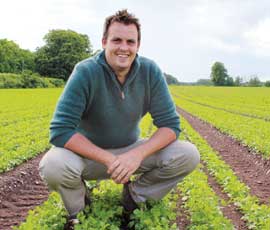
The British rabbit has very discerning tastes when it comes to selecting which coriander variety it chooses to snack on. “I can grow three coriander varieties next to each other which look exactly the same and the rabbits will always chose one specific variety,” says JK Fresh Produce farm manager, Chris Coles (pictured above).
But although the rabbit population may have a taste for the milder tasting varieties, the British public is becoming more experimental with its choice of herbs.
Chris believes the sheer number of cookery programmes showcasing foods from around the world means people are more familiar with ethnic herbs and willing to experiment.
It was this market the JK Fresh Produce’s founder, Surinder Pal, discovered 17 years ago. At the time, the UK imported all of its coriander from Cyprus or Spain. The question was whether it could be grown in Britain.
“After experimenting by growing 10 acres, Surinder discovered it was viable, but the next step was finding a market,” says Chris.
Vendors at Birmingham wholesale market were keen to get involved because British-grown coriander could be bought cheaper than foreign imports. 
Starting in 1996, Surinder sold at wholesale markets every week and increased the area to 40 acres the following year. The business has since grown year-on-year with a greenfield site purchased in 2001.
JK Fresh Produce now stretches across 1,100 acres and has extended further into the ethnic herb market.
As the first to tap into the UK coriander market, in the early “boom years” of the late 1990s the company had few competitors.
This allowed big investment and, although the number of UK coriander farmers has grown, the business is still able to compete both on scale and as a recognised brand. “We’re all about the brand. No one else does branded boxes in the wholesale markets. The fact we vacuum cool our herbs extends the shelf life and is our unique selling point,” he says.
The business grew 1,780t of coriander last year and now supplies supermarkets and 10 wholesale markets across the UK.
Chris explains how in order to maintain a market share for coriander, the key is to get into the market early when the price is high. “If I grow a larger leaf variety, I can sell it early at the normal leaf stage and make the most of the market when Spain and Cyprus have run out,” says Chris.
The business also ensures they can provide the crop all year round, either by growing different varieties on site or importing stocks.
“On average, coriander produces 1,000 boxes an acre with 20 bunches to the box,” says Chris.
“To get the most from the crop, soil pH is crucial, as well as a continuous weather pattern, although obviously this doesn’t happen in the UK.”
To achieve an optimum soil pH of 6.5, four soil samples are taken for every acre squared. Lime is then applied at exact rates using GPS technology.
Drilling starts at the end of February and, as there’s generally seven weeks from planting to harvest, it means they get an average of 3.4 crops every season.
“We rarely harvest a whole field at once, but jump between fields to harvest the best crop at the optimum stage,” he says.
The garlic producer
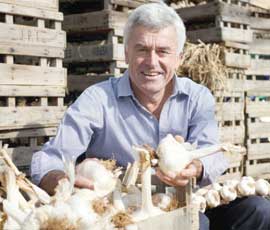
It was thanks to a team of Second World War secret agents on a mission to France that garlic first made it to the shores of the Isle of Wight in 1942.
At the time, The Painters Arms on the island was frequented by a strong contingent of the “free French” who crewed motor torpedo boats based in Cowes.
Such was their yearning for the garlicky taste of home, they placed their request with a flight of special operations executives heading into German-occupied France and were rewarded with a sack of garlic on their return.
It was perhaps a late descendent of this French line that grew in the garden of Colin Boswell’s mother in the mid-1950s and ultimately led to the development of The Garlic Farm on the Island.
When Colin Boswell (pictured above) returned to his parents’ farm in 1976, the family decided to look into alternative crops in addition to sweetcorn growing. With more food writers of the time cooking with garlic, and the Boswell family’s keen interest in cuisine, they decided to look into the feasibility of growing the crop.
“I travelled to France and California to research growing it and quickly found the best garlic for our climate was the mountain garlic from the Auvergne region in France,” explains Colin.
The family started by growing two acres and then quickly began supplying supermarkets. Such was the demand they had to import to meet orders.
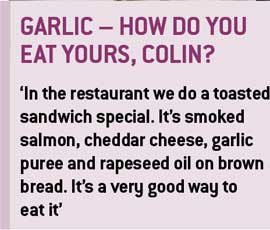
“We now have 60 acres of conventional garlic and 20 acres of elephant garlic. Elephant garlic is from the States and more of a leek with garlic tendencies. It’s not strong and, at 5-6 inches across, it’s for people who want a presence on a plate. It’s a fun vegetable,” says Colin.
However, in 1999 Colin decided to change the business structure and sold the importing business to focus on selling direct to the public.
“We decided to change track and sell to farmers markets and delis. I enjoy selling direct to the customer,” he says.
He now sells bulbs and products direct to the customer and has carved out a business including a restaurant and farm shop selling 50 added value products. Anyone wanting to make the most of the legend surrounding garlic as a way of warding off vampires can take advantage of the “vampire” range which includes Transylvanian pickled garlic and Vampire’s relish. “In the past, people used to hide garlic in things like spag bol, but now it’s come out and people are getting quite addicted to it,” he says.
Conventional garlic is either sown in the spring or autumn depending on variety, with elephant garlic planted early autumn. On average, conventional garlic yields 20,000 bulbs/acre, with 12-16 individual cloves per bulb. Autumn planted cloves are ready in June and spring planted in July.
“You easily get about 30% losses across a field,” says Colin. “Never underestimate the water needs of garlic. We apply four inches of water between April and June through overhead irrigation. In dry years, you will get substantially smaller bulbs.”

